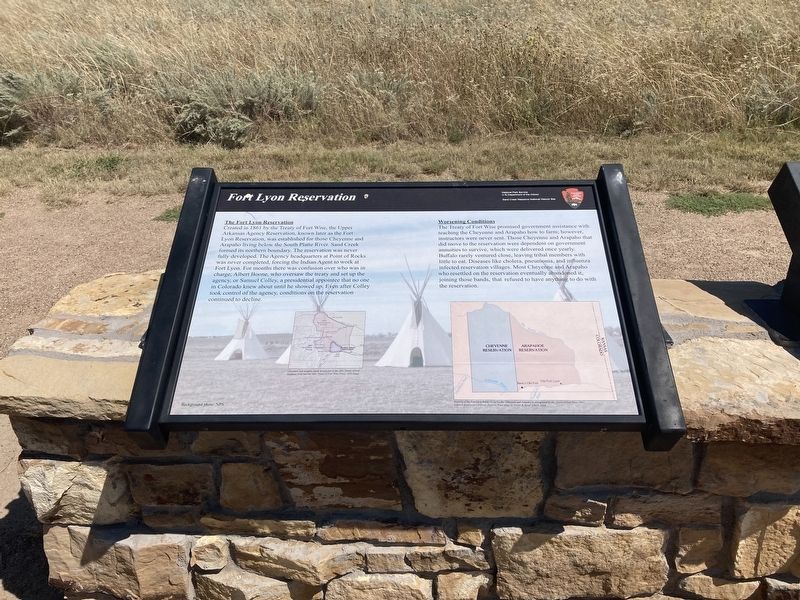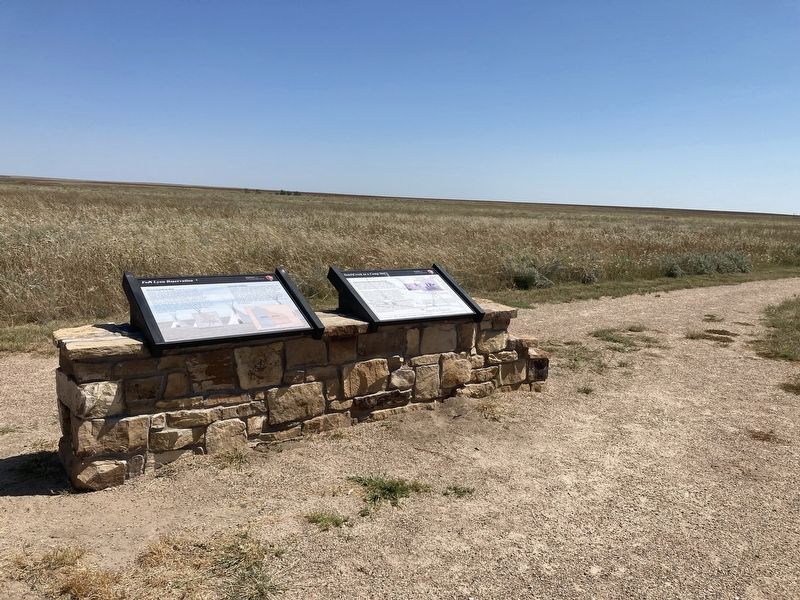Near Chivington in Kiowa County, Colorado — The American Mountains (Southwest)
Fort Lyon Reservation
Created in 1861 by the Treaty of Fort Wise, the Upper Arkansas Agency Reservation, known later as the Fort Lyon Reservation, was established for those Cheyenne and Arapaho living below the South Platte River. Sand Creek formed its northern boundary. The reservation was never fully developed. The Agency headquarters at Point of Rocks was never completed, forcing the Indian Agent to work at Fort Lyon. For months there was confusion over who was in charge; Albert Boone, who oversaw the treaty and set up the agency, or Samuel Colley, a presidential appointee that no one in Colorado knew about until he showed up. Even after Colley took control of the agency, conditions on the reservation continued to decline.
Worsening Conditions
The Treaty of Fort Wise promised government assistance with teaching the Cheyenne and Arapaho how to farm; however, instructors were never sent. Those Cheyenne and Arapaho that did move to the reservation were dependent on government annuities to survive, which were delivered once yearly. Buffalo rarely ventured close, leaving tribal members with little to eat. Diseases like cholera, pneumonia, and influenza infected reservation villages. Most Cheyenne and Arapaho who resettled on the reservation eventually abandoned it, joining those bands, that refused to have anything to do with the reservation.
Captions:
Cheyenne and Arapaho lands designated in the 1851 Treaty of Fort Laramie (red) and the 1861 Treaty of Fort Wise (blue)
Borders of the Fort Lyon Reservation for the Cheyenne and Arapaho as designated by the Treaty of Fort Wise, 1861
Erected by National Park Service.
Topics. This historical marker is listed in this topic list: Native Americans. A significant historical year for this entry is 1861.
Location. 38° 32.838′ N, 102° 30.467′ W. Marker is near Chivington, Colorado, in Kiowa County. Marker can be reached from County Highway W east of Chief White Antelope Way. Located on the Monument Hill Trail. Touch for map. Marker is in this post office area: Eads CO 81036, United States of America. Touch for directions.
Other nearby markers. At least 8 other markers are within walking distance of this marker. Sand Creek as Camp Site (here, next to this marker); The Sand Creek Massacre (approx. ¼ mile away); Conscious and Courage (approx. ¼ mile away); Sacred Memory (approx. ¼ mile away); A Chief’s Village (approx. ¼ mile away); Cheyenne and Arapaho Village at Sand Creek (approx. ¼ mile away); Returned to Sand Creek (approx. ¼ mile away); Welcome to the Sand Creek Massacre National Historic Site (approx. ¼ mile away). Touch for a list and map of all markers in Chivington.
Credits. This page was last revised on September 3, 2021. It was originally submitted on September 2, 2021, by Connor Olson of Kewaskum, Wisconsin. This page has been viewed 217 times since then and 24 times this year. Photos: 1. submitted on September 2, 2021, by Connor Olson of Kewaskum, Wisconsin. 2. submitted on September 3, 2021, by Connor Olson of Kewaskum, Wisconsin. • Andrew Ruppenstein was the editor who published this page.

